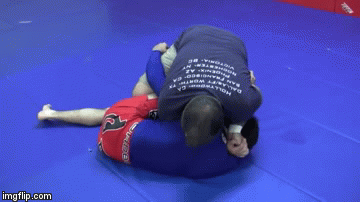
Submissions in Brazilian Jiu-Jitsu come in all shapes and sizes. Some work by carefully advancing inch by inch until the opponent has nowhere to go. Others come at you like a freight train, you know what’s going to happen and you’re powerless to avoid it. Another category is blitz submissions, those opportunistic moves that are usually low percentage until the circumstances are just right. And then, there are the sneaky submissions, the moves that get you when you think you’re safe. BJJ necktie submissions fall under each of these categories, depending on circumstances. They’re a large family of attacks that can work together as a comprehensive submission system.
With BJJ necktie submissions, the main question that arises is whether they’re choice or neck cranks? It is one we’re going to answer further down in this article. In essence, BJJ necktie submissions are arm-in choke variations, that usually work from a front headlock-like position. They are brutal submissions that are hiding in plain sight. Neckties also work as pit stops between other chokes, offering much fewer escape possibilities for your opponent.s And, which is probably their greatest advantage, they’re as versatile as it gets.
Naming the neckties is another very interesting aspect of these submissions. Where and how it all started is unclear, but what we know is that every necktie is connected to a country. In that sense, you have Peruvian, Japanese, Mexican, German, Jamaican and many more neckties. At some point in time, there’ll probably be as many BJJ necktie submission variations as there are nationalities. So far, there are a bunch that works and a few others that need some fine-tuning. However, they’re a very powerful weapon to have, especially for those training and competing in the Gi. Let’s take a look at the world of neckties and the variations you need if you’re going to be a formidable grappler.
What Makes BJJ Necktie Submissions Effective
The mechanics of the BJJ necktie submission are fairly simple to grasp. As far as the mechanics go, neckties work primarily as arm-in chokes. the whole difference between an arm-triangle choke or guillotine is in body positioning and gripping. With neckties, your whole body acts as a wedge against the opponent’s head, helping the choke along. there’s also a twisting component to most neckties, courtesy of the grips. This adds both pressures on a choke, or a neck crank option, depending on circumstances.
Since it’s impossible to explain how a BJJ necktie submission works in general, we’ll use one of the variations as an example to explain the mechanics. Further on, we’ll look at many other variations and compare them to our “gold standard” necktie. For that purpose, we’re going to focus on the Japanese Necktie.

finishing the necktie involves lying down on the shoulder of your top arm side. This puts your belly behind the opponent’s head. It provides a source of immense pressure as well as adding a twisting motion to the neck. The leg in half guard is something you actually need to finish, as it crunches and twits your opponent up even further.
BJJ Necktie Variations
In terms of the neck-crank conundrum let’s make something clear, rule-wise. Any and all neck cranking stemming from BJJ neckties submissions is not grounds for disqualification. These submissions are primarily chokes, constricting the carotid arteries to block the blood supply to the brain. So, any cranking effects are the same as a badly placed Rear Naked Choke. They’re legal and more of a side-effect. This means you can use neckties to your advantage as you can turn them into cranks on purpose if you wish so.
The origins of the neckties are not really clear. this is just a guess, but whoever came up with the Peruvian necktie must’ve used the name as it sounds coo land very appropriate. a Peruvian (or Bolivian necktie) is a method of murder common to prisons, involving a V-shaped cut on the neck. Most likely, from there on, people just started adding nationalities in front of BJJ necktie setups, resulting in today’s arsenal. Whatever the history, they’re a bunch of really slick submissions at present!
Neil Melanson knows all there is to know about neckties. Actually, he is the one behind the German necktie variation. If you want to learn how to use them in conjunction with other front headlock chokes, check out Neil’s “Headhunter Guillotine Series” DVD instructional. Check out what this amazing DVD has to offer in our detailed review.
Peruvian Necktie
Since we already covered the Japanese necktie, we’re now going to go over a BJJ necktie classic – the Peruvian. The Peruvian necktie is the perfect submission to hit a from a front headlock against the turtle position. Very often you can get the front headlock but not sufficiently deep grips for a guillotine or an Anaconda choke. This means you can either transition to the back or use the Peruvian necktie to finish directly and painfully.

German Necktie
The German necktie is kind of a blend between the Japanese and the Peruvian neckties. Since we already know that both these moves work perfectly, a hybrid must double the effectiveness, right? Well, that’s actually not far from the truth.

To finish, simply extend and pinch your elbows, throw your free leg over the opponent’s head and post on the top of your head behind the opponent’s back. You’re essentially using Peruvian necktie mechanics to finish hs from a Japanese necktie position. Really effective!
Texas Necktie
The Texas necktie is kind of the ultimate BJJ necktie finish you can go for. It is a way to counter the best way someone can defend a D’arce or Japanese necktie – lying down flat. Whenever this happens you can look to use the grip you have to force your opponent to their knees and back down on their side. Or, you can go for a direct finish, right then and there.

Chilean Necktie
The Chilean necktie is a BJJ necktie variation that involves the use of the Gi. Whenever an opponent turns away from you in side control, you can think about this submission. it’s easier to set up than taking the back and it opens up armbars and back takes in case it fails.

Mexican Necktie

Australian Necktie

Speaking of Australian neckties, Lachlan Giles is by far the ultimate authority. The “High Percentage Chokes: No-GI” 4 DVD set covers everything you’ll ever need to learn about choking people without the GI. It focuses heavily on front headlock chokes and includes very cool necktie setups. Get it ASAP and start getting a boatload of taps!
Armenian Necktie
Here’s an interesting one. The Armenian necktie is a shortcut between the German and Australian. Since it’s halfway there, you can look to wrap things up with it, instead of going all the way to an Australian.

Colombian Necktie

Once you have the grip in, angle off to one side, just like when attacking an armbar from the back. Throw the bottom leg over the neck/chest area, looking to lock in a triangle with the other leg. The second leg should go over the opponent’s opposite shoulder. Squeeze everything to get your opponent crying.
Brazilian Necktie

Finishing is as easy as projecting forward in order to open up space to swing your leg over the opponent’s head. Aim to get your knee over the opponent’s chin so that you have maximal leverage. Use the leg to push their head towards your bottom arm, this creating a choke.
Related Articles:
Guillotine Choke – Basics, Secrets, and Variations to Make it Perfect
Turning A Choke Into A Neck Crank – Legit Or Cheap?
Top And Bottom Baseball Choke Setups For Jiu-Jitsu
Peruvian Necktie
Japanese Necktie











































